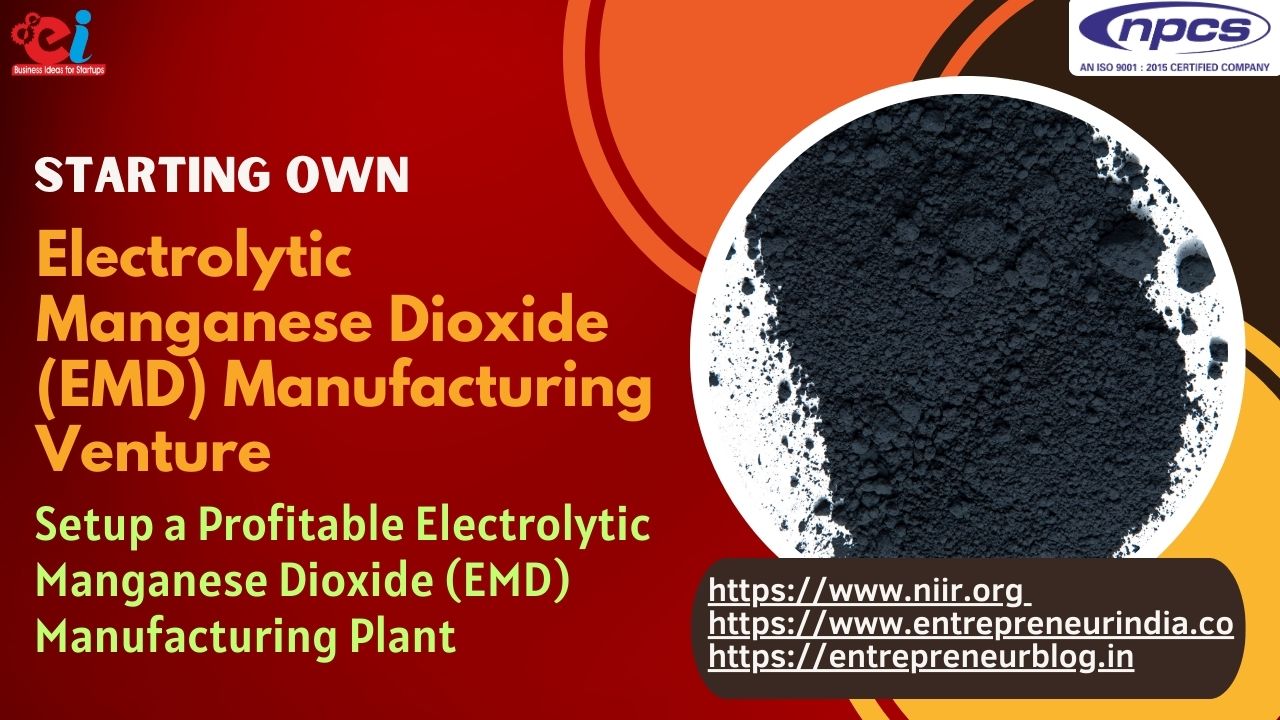Manganese dioxide is a critical component in the production of alkaline batteries as well as other digital tools. Electrolytic Manganese Dioxide (EMD) is a high-purity product made use of largely in dry cell batteries. As the demand for mobile electronic gadgets grows, the significance of EMD in the global market can not be overstated. This article explores the feasibility, techno-economic practicality, and potential investment opportunities in the EMD manufacturing sector.
Market Size, Share, and Trends:
The international EMD market has actually seen significant growth over the past years. With the surge popular for batteries in customer electronics, electric vehicles, and renewable energy storage services, the EMD market is predicted to get to new heights. Asia-Pacific, especially China, controls the marketplace share because of its huge customer electronic devices sector as well as growing electrical vehicle market.
Visit this Page for More Information: Start a Business in Battery Industry
SWOT Analysis:
Strengths:
- Growing demand for batteries in various sectors.
- Technological advancements leading to higher efficiency in EMD production.
- Established supply chains in major markets.
Weaknesses:
- Environmental concerns related to mining and production.
- Dependence on manganese ore availability.
- High initial capital investment.
Opportunities:
- Expansion in electric vehicle and renewable energy sectors.
- Potential for innovation in production processes.
- Growing markets in developing countries.
Threats:
- Regulatory changes affecting production and distribution.
- Competition from alternative battery technologies.
- Fluctuating global economic conditions.
Profitability Analysis:
The profitability of EMD production hinges on factors like raw material costs, technological efficiency, and market demand. With the current upward trajectory in demand for batteries, investing in EMD production can yield significant returns. However, it’s crucial to optimize production processes and ensure a steady supply of manganese ore.
Related Feasibility Study Report: Electrolytic Manganese Dioxide – Manufacturing Plant, Detailed Project Report, Profile, Business Plan, Industry Trends, Market Research, Survey, Manufacturing Process, Machinery, Raw Materials, Feasibility Study, Investment Opportunities, Cost and Revenue
Global Expansion and Localization:
While the Asia-Pacific region is a significant market, there’s potential for expansion in North America, Europe, and Africa. Localization is crucial to cater to specific market needs and ensure compliance with regional regulations. Establishing local partnerships can aid in navigating regulatory landscapes and optimizing supply chains.
Supply Chain:
A robust supply chain is vital for the EMD industry. From sourcing manganese ore to distributing the final product, every step must be optimized for cost and efficiency. Investing in sustainable mining practices and establishing long-term partnerships with suppliers can ensure a steady flow of raw materials.
Branding and Marketing:
Building a strong brand in the EMD industry requires a focus on quality, sustainability, and innovation. Marketing strategies should highlight the product’s purity, efficiency, and environmental benefits. Collaborating with battery manufacturers and electronic brands can also enhance market visibility.
Regulatory Changes and Industry Compliance:
The EMD industry is subject to various regulations, especially concerning environmental standards. Staying updated with global regulatory changes and ensuring compliance is crucial to avoid legal complications and maintain a positive brand image.
Technological Innovation:
Innovation is the key to staying competitive in the EMD market. Investing in R&D can lead to more efficient production processes, reducing costs, and increasing product purity. Embracing new technologies can also aid in addressing environmental concerns.
Competitor Analysis:
The EMD market is competitive, with several key players dominating the landscape. Regularly analyzing competitors’ strategies, strengths, and weaknesses can provide insights into market trends and potential areas of improvement.
Read our Books Here: Battery Production, Recycling, Lithium Ion, Lead-Acid Batteries
Frequently Asked Questions:
- What Is The Primary Use Of EMD?
- EMD is primarily used in dry cell batteries.
- How Does EMD Production Impact The Environment?
- EMD production can have environmental implications, especially in mining. However, sustainable practices can mitigate these effects.
- Are There Alternatives To EMD In Battery Production?
- Yes, there are alternative materials, but EMD remains a preferred choice due to its efficiency and cost-effectiveness.
Future Opportunities:
The future of the EMD industry looks promising. With the rise of electric vehicles and the continuous demand for portable electronics, the need for high-quality EMD will only grow. Exploring untapped markets, investing in sustainable production methods, and fostering innovation can lead to unprecedented growth in the coming years.
The Strategic Importance of EMD:
Electrolytic Manganese Dioxide’s significance extends beyond just battery production. Its high purity and efficiency make it a preferred choice in various applications, from water treatment to electronics. As industries evolve and technology advances, the strategic importance of EMD in the global market is set to increase.
Investment Considerations:
Before diving into the EMD manufacturing industry, potential investors should consider several factors:
- Raw Material Availability: The primary raw material for EMD production is manganese ore. Ensuring a consistent supply is crucial. Investors should consider the geographical location of the manufacturing unit in relation to manganese ore mines.
- Technological Infrastructure: Modern EMD production requires sophisticated machinery and technology. The initial capital expenditure might be high, but the returns, given the growing demand, can be substantial.
- Market Dynamics: Understanding the current market dynamics, including demand-supply gaps, regional preferences, and potential growth areas, is essential.
Economic Viability:
The economic viability of EMD production is influenced by various factors:
- Cost of Production: This includes raw material costs, labor, technology, and overheads. Efficient production processes can significantly reduce these costs.
- Selling Price: The global selling price of EMD is influenced by market demand, competition, and production costs. It’s essential to strike a balance to ensure profitability.
- Demand Projections: With the rise of electric vehicles and renewable energy solutions, the demand for EMD is set to grow. However, it’s crucial to keep an eye on market trends and adjust production accordingly.
Localization vs. Globalization:
While global expansion offers a broader market, localization provides a deeper penetration into specific markets. Both strategies have their merits:
- Localization: Tailoring production and marketing strategies to cater to local demands can lead to better market penetration. It also aids in navigating local regulations and customs.
- Globalization: Expanding to global markets offers a larger customer base. It also provides a buffer against regional economic downturns.
Branding Strategies:
In the EMD industry, branding isn’t just about visibility; it’s about trust. Customers, especially large-scale manufacturers, need to trust the quality and consistency of the EMD. Effective branding strategies include:
- Quality Assurance: Regularly testing and ensuring the high purity of the EMD can be a strong selling point.
- Sustainability: Highlighting sustainable mining and production practices can appeal to environmentally conscious customers.
- Innovation: Showcasing continuous R&D efforts can position the brand as a market leader.
Regulatory Landscape:
The regulatory landscape for EMD production varies across countries. Some key considerations include:
- Environmental Regulations: Many countries have strict environmental regulations concerning mining and production. Ensuring compliance is not just a legal necessity but also a branding opportunity.
- Trade Tariffs: For those looking to export EMD, understanding trade tariffs and agreements is crucial. Some regions might have favorable trade agreements, making exports more profitable.
- Local Regulations: These can include labor laws, safety standards, and more. Adhering to these not only ensures smooth operations but also builds trust with local stakeholders.
Technological Advancements:
The future of EMD production lies in technology. Some potential advancements include:
- Automated Production Lines: These can increase production efficiency and reduce labor costs.
- AI and Machine Learning: These technologies can optimize production processes, predict market trends, and even aid in R&D.
- Sustainable Technologies: Innovations that reduce the environmental impact of EMD production can be both economically beneficial and marketable.
Competitive Landscape:
Understanding the competitive landscape is crucial for any business, more so for a niche market like EMD. Regular SWOT analyses, market research, and competitor benchmarking can provide valuable insights.
Frequently Asked Questions:
- How Does EMD Compare To Natural Manganese Dioxide In Battery Production?
-
- EMD, due to its high purity, offers better efficiency and consistency in battery production compared to natural manganese dioxide.
- What Are The Primary Challenges In EMD Production?
- Some challenges include ensuring a consistent raw material supply, adhering to environmental regulations, and staying competitive in terms of pricing and quality.
- Is There Potential For Vertical Integration in the EMD Industry?
- Yes, companies can look into integrating operations from manganese ore mining to EMD production and even battery manufacturing. This can lead to cost savings and better market control.
Future Opportunities (Expanded):
- Collaborations: Working together with battery manufacturers, electronic brands, and also electrical car companies can open up new avenues for growth.
- Diversification: While batteries are the primary use EMD, there are other applications, like in the glass as well as ceramics industry, which can be explored.
- Research & Development: Purchasing R&D can bring about the exploration of brand-new applications for EMD, more reliable production approaches, as well as also completely brand-new items.
Conclusion
The EMD production industry, with its existing growth trajectory and also future potential, presents a compelling case for financial investment. Nevertheless, like any type of market, it comes with its difficulties. Possible capitalists ought to perform detailed research, comprehend the marketplace characteristics, and also be prepared for technological and also governing shifts. With the best approaches and also a forward-looking strategy, the rewards can be considerable.
Visit the page Select and Choose the Right Business Startup for You for sorting out the questions arising in your mind before starting any business and know which start-up you can plan.
We, at NPCS, endeavor to make business selection a simple and convenient step for any entrepreneur/startup. Our expert team, by capitalizing on its dexterity and decade’s long experience in the field, has created a list of profitable ventures for entrepreneurs who wish to diversify or venture. The list so mentioned is updated regularly to give you a regular dose of new emerging opportunities.
Click here to send your queries/Contact Us
Purchasing a detailed NPCS (Niir Project Consultancy Services) report can provide several benefits, particularly for businesses and individuals looking to invest in new ventures or understand industry trends. Here are some reasons why one might consider buying an NPCS report:
- Detailed Market Analysis: NPCS reports provide in-depth analyses of various markets, including understanding market size, growth rates, demand and supply trends, and key players.
- Feasibility Studies: These reports often include feasibility studies for various projects, giving potential investors an understanding of the project’s viability, expected returns, and risks involved.
- Industry Trends and Forecasts: NPCS reports help investors understand the latest trends in specific industries and future forecasts, helping in strategic decision making.
- Technological Insights: These reports can provide valuable information about the latest technological advancements and how they are impacting specific sectors.
- Regulatory Framework: Understanding the regulatory landscape of an industry or market is crucial for business planning. NPCS reports provide detailed information on the regulatory environment and potential changes.
- Competitive Landscape: NPCS reports also offer insights into the competitive environment of an industry, outlining major competitors, their market shares, and their strategies.
- SWOT Analysis: These reports often include SWOT analyses (Strengths, Weaknesses, Opportunities, Threats) of the industries they cover, providing a balanced view of the pros and cons of investing in those sectors.
- Investment Guidance: For businesses and individuals looking to invest in new ventures, NPCS reports can provide a thorough understanding of the industry, helping them make informed investment decisions.
- Business Planning: Whether starting a new business or expanding an existing one, NPCS reports can be beneficial in business planning by providing comprehensive industry and market information.
- Tailored Information: NPCS reports can be customized according to specific needs, ensuring that businesses get the most relevant and useful information for their unique situation.
In conclusion, an NPCS report can be an invaluable tool in understanding an industry or market, aiding in decision-making, planning, and investment strategies.
See More Links:
- Start a Business in Asia
- Start a Business in Potential Countries for Doing Business
- Best Industry for Doing Business
- Business Ideas with Low, Medium & High Investment
- Looking for Most Demandable Business Ideas for Startups
- Startup Consulting Services
- Start a Business in Africa
- Start a Business in India
- Start a Business in Middle East
- Related Videos
- Related Books
- Related Projects
- Related Market Research Reports
- Read Our Blog Here
OF_20Art23





